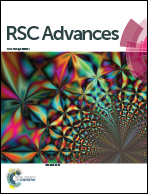Biodegradation of 2,4-dinitrotoluene with Rhodococcus pyridinivorans NT2: characteristics, kinetic modeling, physiological responses and metabolic pathway†
Abstract
2,4-Dinitrotoluene (2,4-DNT), a major by-product during the synthesis of 2,4,6-trinitrotoluene, is widely used as a gelatinizing, waterproofing and plasticizing agent in explosives and propellants. Since DNTs and its metabolites exhibit toxicity to human beings, fish, algae and microorganisms, they are treated as priority pollutant in several countries. This study describes the biodegradation of 2,4-DNT in batch mode by Rhodococcus pyridinivorans NT2 in the range of 0.5–2 mM. At initial concentration of 0.54 mM, degradation kinetics were described well by zero-order model. However, modeling of the biodegradation at higher concentrations indicated that the Andrews–Haldane model predicts the experimental data fairly well. During growth and biodegradation, changes in saturated/unsaturated ratio of fatty acids, total cyclo fatty acids, and the ratio of anteiso:iso-branching were observed. This was accompanied by increased cell size, alternation in enzymatic and non-enzymatic antioxidant defense systems, accumulation of biosurfactants and carotenoids. Biodegradation of 2,4-DNT by this strain proceeded through a pathway involving intermediates such as 2-amino-4-nitrotoluene and 2,4-diaminotoluene. The strain NT2 harbored plasmid that was found to be associated with biodegradation.


 Please wait while we load your content...
Please wait while we load your content...